◄ Carnets Geol. 13 (A09) ►
Contents
[1. Introduction] [2. Geological Background] [3. Systematics]
[4. Discussion] [Bibliographic references]
Department of Geology, University of Tartu, Ravila 14A, EE-50411 Tartu (Estonia)
Department of Geology, The College of Wooster, Wooster, OH 44691 (USA)
Manuscript online since December 25, 2013
[Editor: Christian C. ]
Seven species of cornulitids are systematically described from the Silurian of Saaremaa and Hiiumaa islands, Estonia. There are three species of cornulitids in the Rhuddanian, three in the Sheinwoodian, single species in the Gorstian and Ludfordian, and three species in the Pridoli. Cornulitids have a facies range from pelletal limestones of shoal environments to deeper ramp marls. Endobiotic cornulitid symbionts occur in stromatoporoids found in shoal and open shelf zones. Gregarious aggregates are restricted to the limestones of the open shelf zone possibly because of higher nutrient levels in open shelf zone waters as compared to those of the deeper ramp. Unattached free forms are especially common in offshore deeper ramp marls presumably due to their adaption to life on a soft bottom. Solitary attached forms occur in all facies zones where cornulitids are present. Because the life modes of cornulitids are closely associated with particular facies zones, they are useful tools for paleoecological reconstructions.
Tentaculita; Cornulitida; sedimentary facies; stratigraphic distribution; Silurian; Baltica.
O. & M.A. (2013).- Silurian cornulitids of Estonia (Baltica).- Carnets de Géologie [Notebooks on Geology], Brest, Article 2013/09 (CG2013_A09), p. 357-368.
Cornulitides siluriens d'Estonie (Baltica).- Sept espèces de cornulitides provenant du Silurien des îles Saaremaa et Hiiumaa en Estonie sont décrites : trois espèces sont présentes dans le Rhuddanien, trois dans le Sheinwoodien, une dans le Gorstien et le Ludfordien, et trois espèces dans le Pridoli. Ces cornulitides se rencontrent dans une gamme de faciès allant des calcaires péloïdaux correspondant à des hauts-fonds jusqu'aux marnes représentant la portion la plus profonde de la rampe carbonatée. Des cornulitides symbiotiques et endobiontes sont présents dans les stromatoporoïdés observés dans les domaines de haut-fond et de plate-forme ouverte. Les agrégats de cornulitides sont limités aux calcaires du domaine de plate-forme ouverte, probablement en raison de taux en nutriments plus élevés dans ces eaux que dans celles de la rampe plus profonde. Seules les formes libres sont particulièrement fréquentes dans les marnes de la rampe plus profonde, sans doute en raison de leur adaptation à la vie sur des sédiments meubles. Des formes solitaires attachées s'observent dans toutes les ceintures de faciès où les cornulitides sont présents. Parce que les modes de vie des cornulitides sont étroitement associés à des zones particulières de faciès, ils constituent des outils utiles pour les reconstructions paléoécologiques.
Tentaculita ; Cornulitida ; faciès sédimentaire ; distribution stratigraphique ; Silurien ; Baltica.
Cornulitids are palaeoecologically important as hard substrate encrusters that generally retain their original position on the substrate after fossilization ( & , 2003). However, they have a smaller stratigraphic importance than their free living descendants the tenataculitids (, 2006; & , 2011). Cornulitid tubeworms are found only in normal marine sediments of the Ordovician to Carboniferous (, 2010). In this respect they differ from their close relatives, the microconchids, which lived in waters of various salinities (e.g., et al., 2012, 2013). Cornulitid tubeworms are especially common in shallow marine sediments associated with carbonate platforms ( & 2013). Cornulitids had diverse forms including free-living varieties and symbiotic endobionts (, 2010). Cornulitids form an order of the encrusting tentaculitoid tubeworms and are presumably ancestors of free-living tentaculitids ( & , 2009; , 2010). Their biological affinities have been debated since their discovery in the early 19th century. They have been affiliated with various groups of invertebrates, but most likely belong to the Lophothrochozoa according to a recent study by & (2012). They could represent stem-group phoronids ( et al., 2010).
The taxonomy of Silurian cornulitids of Estonia is poorly studied, mostly due to their minor stratigraphical importance. The earliest records of cornulitids from the Silurian of Estonia are by (1858) and (1860). Recently a new species of endobiotic cornulitids was described from the Wenlock of Estonia ( & , 2010). Most of the cornulitid species here are described in open nomenclature because of taxonomic uncertainties and the small number of specimens available for study. The majority of Silurian cornulitids were described from North America and Europe in the 19th century. These species need to be revised before one can attempt to identify them in the Silurian of Estonia. Cornulitids have usually been treated as the minor group in the Silurian of Estonia, but they can be abundant as encrusters on various shelly fossils and hardgrounds ( & , 2010). The free solitary species Cornulites celatus, et al., 2007, is very common in the Sheinwoodian of Saaremaa (, 2009).
The specimens studied here are housed in the Museum of Geology (Natural History Museum), University of Tartu (TUG).
Baltica was located in equatorial latitudes and continued its drift northward during the Silurian ( et al.,
2004). In the Silurian the area of modern Estonia (Fig. 1 ![]() ) was variously part of the epicontinental Baltic paleobasin that was characterized by a wide range of tropical environments and diverse biotas ( et al.,
2008).
) was variously part of the epicontinental Baltic paleobasin that was characterized by a wide range of tropical environments and diverse biotas ( et al.,
2008).

Click on thumbnail to enlarge the image.
Figure 1: Map (modified after , 2006) showing the location of study area and the localities. 1: Hilliste Quarry; 2 Orissare; 3: Panga cliff; 4: Ninase cliff; 5: Undva cliff; 6: Abula cliff; 7: Sauvere; 8: Marienthal; 9: Kaugatuma cliff; 10: Ohesaare cliff.
Five depositional environments have been recognized by &
(1977) in the Baltic Silurian Basin: tidal flat/lagoonal, shoal, open shelf, transitional (basin slope), and a basin depression. The first three environments formed a carbonate platform with various carbonate sediments, and the latter two formed a deeper basin with fine-grained siliciclastic deposits ( & ,
1997). The Silurian succession (Fig. 2 ![]() ) is represented by shallow water carbonate rocks rich in shelly faunas in the outcrop area, which includes Saaremaa and Hiiumaa islands.
) is represented by shallow water carbonate rocks rich in shelly faunas in the outcrop area, which includes Saaremaa and Hiiumaa islands.
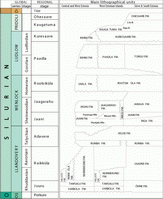
Click on thumbnail to enlarge the image.
Figure 2: The Silurian stratigraphical chart of Estonia. Modified after (2008).
Phylum incertae sedis
Class Tentaculitida , 1964
Order Cornulitida , 1964
Family Cornulitidae , 1962
Genus Cornulites , 1820
Cornulites aff. serpularius , 1820
Material: 21 complete shells (in two aggregations, plus one solitary specimen)
Locality: Orissaare, Saaremaa, Estonia (Fig. 1 ![]() ).
).
Stratigraphy: Jaani Formation, Sheinwoodian (Lower Silurian) (Fig. 2 ![]() ).
).
Notes: Straight to slightly curved tubicolous shells, attached to the substrate only in the proximal part. They form small gregarious aggregates. Tubes are up to 24 mm long. The diameter of aperture 5 to 6 mm in adult tubes. Tube expands moderately in diameter. Tube divergence angle is about 14°. External surface of the tube is covered with weakly developed irregular perpendicular annulation and irregular perpendicular growth lines of variable development. There are 5 to 7 growth lines per 1 mm near the aperture. The tube exterior is covered with well-developed regular longitudinal costae, about 8 to 9 costae per 1 mm near the aperture. The tube lumen is covered with moderately developed annuli, about 1.5 to 2.0 mm wide near the aperture. Tube wall thin, 0.1 mm thick between annular crests and up to 1.0 mm thick at the annular crests. Tube structure vesicular at annular crests and lamellar between them.
Remarks: Described specimens are affiliated with C. serpularius because of similar size and divergence angle of the tubicolous shell. 's types of C. serpularius are entirely attached along their lengths to a brachiopod shell. They are slightly curved and solitary. A solitary specimen (Fig. 4 ![]() ), attached in its entirety to a gastropod shell could also belong to C. aff. serpularius, but it has much coarser costae (5 costae per 1 mm).
), attached in its entirety to a gastropod shell could also belong to C. aff. serpularius, but it has much coarser costae (5 costae per 1 mm).
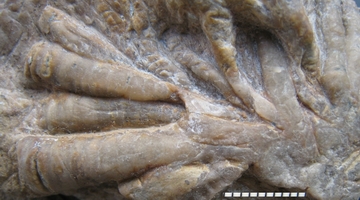
Click on thumbnail to enlarge the image.
Figure 3: Cornulites aff. serpularius, Jaani Formation, Sheinwoodian from Orissaare, Saaremaa. Scale in millimeters. TUG 1658-1.
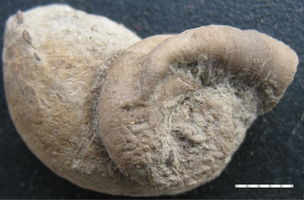
Click on thumbnail to enlarge the image.
Figure 4: Cornulites aff. serpularius?, Jaani Formation, Sheinwoodian from Paramaja cliff, Saaremaa. Scale in millimeters. TUG 1658-2.
Cornulites cellulosus et al., 2007
2007 Cornulites cellulosus – et al., p. 686-687,
Figs. 1B, 2C–J, 4A–M, 5A–G, 6A, B, 9A, B
2009 Cornulites cellulosus – , p. 88,
Figs. B-C, E
Material: 46 complete and partially preserved shells.
Locality: Paramaja cliff, Ninase cliff, and Panga cliff, Saaremaa, Estonia (Fig. 1 ![]() ).
).
Stratigraphy: Jaani Formation, Paramaja Member and Ninase Member, Sheinwoodian (lower Silurian) (Fig. 2 ![]() ).
).
Notes: Straight to slightly curved large tubicolous shells, not attached to a substrate. Tubes are up to 60.0 mm long. The diameter of aperture is 13.0 to 18.0 mm in adult tubes. Tube expanded moderately to quickly in diameter. Tube divergence angle is 14° to 18°. External surface of the tube covered with weakly developed relatively regular perpendicular annulations and irregular perpendicular growth lines of variable development. Slightly eroded specimens have well developed strong regular external annulation. There are 3 to 5 growth lines per 1 mm near the aperture. The tube exterior is covered with well-developed regular longitudinal costae; about 5 to 6 costae per 1 mm near the aperture. New costae appear by intercalation. Two old costae can merge. The tube lumen is covered with well-developed annuli, about 3.5 to 4.5 mm wide near the aperture. Tube wall is thick, 0.5 mm thick between annular crests and up to 1.0 mm thick at the annular crests in (at diameter 6.0 mm). Tube structure is vesicular at annular crests and lamellar between them. In large specimens the tube wall is up to 4.0 mm thick, completely vesicular in apertural part. Septa occur in the proximal part of the tube.
Remarks: Described specimens are assigned to C. cellulosus because of similar shape, size and ornamentation. They also have similar wall structure.
Figure 5: Cornulites cellulosus, a weathered specimen, Jaani Formation, Sheinwoodian from Paramaja cliff, Saaremaa. Scale in millimeters. TUG 119-194.
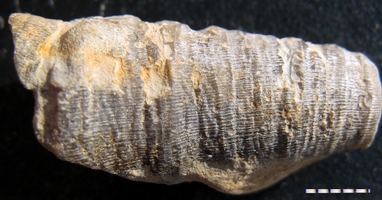
Click on thumbnail to enlarge the image.
Figure 6: Cornulites cellulosus, Jaani Formation, Sheinwoodian from Paramaja cliff, Saaremaa. Scale in millimeters. TUG 1658-3.
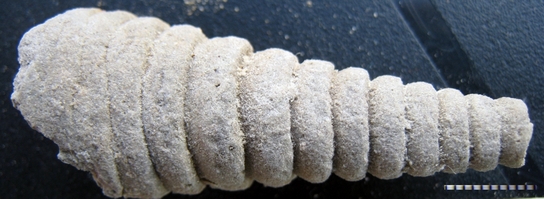
Click on thumbnail to enlarge the image.
Figure 7: Cornulites cellulosus, internal mold, Jaani Formation, Sheinwoodian from Panga cliff, Saaremaa. Scale in millimeters. TUG 1658-4.
Cornulites stromatoporoides & , 2010
(Fig. 8 ![]() )
)
2010 Cornulites stromatoporoides – & , p. 20,
Figs. 2-4, 6.
2010 Cornulites stromatoporoides – , p. 215,
Fig. 5.
Material: Tens of complete tubes and tube fragments.
Locality: Undva cliff, Suuriku cliff, Panga cliff, and Abula cliff, Saaremaa, Estonia (Fig. 1 ![]() ).
).
Stratigraphy: Jaani Formation to Jaagarahu Formation, Sheinwoodian (lower Silurian) (Fig. 2 ![]() ).
).
Notes: Straight to slightly curved tubicolous shells, completely embedded in stromatoporoids. Tubes are up to 30 mm long. The diameter of the apertures 5 to 8 mm in adult tubes. Tube expands relatively quickly in diameter. Tube divergence angle is about 20°. External surface of the tube is covered with weakly developed relatively irregular perpendicular annulations and irregular perpendicular growth lines of variable development. The tube exterior is covered with faint regular longitudinal costae. There are 7 to 9 costae per 1 mm. Tube lumen is covered by prominent annuli which are better developed in large mature specimens. The internal annuli are 1.7-2.1 mm high at tube diameters of 10.0 mm, 1.5-2.0 mm high at tube diameters of 5.0 mm, and 0.8-1.0 mm high at tube diameter of 2.0 mm. Tube wall is relatively thin; 0.6-0.8 mm thick at a diameter of 5.0 mm. Wall structure is completely vesicular in the mature part of the tube. Multiple septa occur in proximal part of the adult tubes.

Click on thumbnail to enlarge the image.
Figure 8: Cornulites stromatoporoides, Jaani Formation, Sheinwoodian from Panga cliff, Saaremaa. Scale bar 10 mm. TUG-1328-1.
Cornulites sp. 1
(Fig. 9 ![]() )
)
Material: Two complete shells.
Locality: Hilliste quarry, Hiiumaa, Estonia (Fig. 1 ![]() ).
).
Stratigraphy: Hilliste Formation, Rhuddanian (lower Silurian) (Fig. 2 ![]() ).
).
Description: Straight to slightly curved, minute tubicolous shells entirely attached to the substrate. Tubes are up to 7.0 mm long. The diameter of aperture 1.4 to 1.5 mm. Tube expanded relatively slowly in diameter. Tube divergence angle is about 12°. Tubes are externally covered with strong regular perpendicular ridges. At the contact with the substrate, perpendicular ridges protrude from the tube wall; otherwise tubes base not widened. Faint and fine longitudinal costae cover the external surface of the tubes. There are about 12 to 13 costae per 1mm. Tube lumen is annulated.
Remarks: Described specimens are attached to a crinoid columnal and a stromatoporoid.
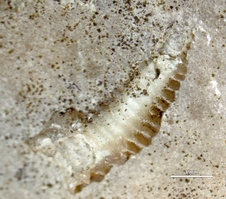
Click on thumbnail to enlarge the image.
Figure 9: Cornulites sp. 1, Hilliste Formation, Rhuddanian, from Hilliste Quarry, Hiiumaa.
Cornulites sp. 2
(Fig. 10 ![]() )
)
Material: Ten complete shells, two partially preserved shells.
Locality: Hilliste quarry, Hiiumaa, Estonia (Fig. 1 ![]() ).
).
Stratigraphy: Hilliste Formation, Rhuddanian (lower Silurian) (Fig. 2 ![]() ).
).
Description: Variably curved small tubicolous shells, entirely attached to the substrate. Tubes are up to 9.0 mm long. The diameter of aperture 1.3 to 1.5 mm. Tube expanded relatively slowly to moderately in diameter. Tube divergence angle is about 13°. Tubes externally covered with weakly developed irregular annulations. Faint, fine longitudinal costae cover the external surface of the tubes. There are about 13 to 14 costae per 1mm. Tube base not widened. Tube lumen annulated.
Remarks: Seven specimens are attached to a single gastropod specimen (Cyclonema sp.). C. sp. 2 resembles C. sp. 1 in its small size. It differs from C. sp. 2 in having much stronger and more regular perpendicular ornamentation.

Click on thumbnail to enlarge the image.
Figure 10: Cornulites sp. 2, Hilliste Formation, Rhuddanian from Hilliste Quarry, Hiiumaa. Scale bar 1.5 mm. TUG 66-112.
Cornulites sp. 3
(Fig. 11 ![]() )
)
Material: Four complete shells.
Locality: Kaugatuma cliff, Saaremaa, Estonia (Fig. 1 ![]() )
)
Stratigraphy: Kaugatuma Formation, Äigu Beds, lower Pridoli (upper Silurian) (Fig. 2 ![]() ).
).
Description: Variably curved tubicolous shells of moderate size, entirely attached to substrate. Tube expanded relatively slowly in diameter. Tubes are up to 19 m long and 2.5 mm wide. Tubes externally covered with moderately developed irregular annulations. Tube wall thin, 0.3 mm thick. Tube lumen annulated. Internal annular crests weakly developed in the proximal part of the tube.
Remarks: Studied specimens are weathered and too poorly preserved to study the details of external ornamentation. Specimens are attached to rugosans and brachiopods.

Click on thumbnail to enlarge the image.
Figure 11: Cornulites sp. 3, Kaugatuma Formation, Pridoli from Kaugatuma cliff, Saaremaa. Scale bar 2.5 mm. TUG 143-94.
Cornulites sp. 4
(Fig. 12 ![]() )
)
Material: 15 complete and partially preserved shells, including two aggregations.
Locality: Ohesaare cliff, Saaremaa, Estonia (Fig. 1 ![]() ).
).
Stratigraphy: Ohesaare Formation, upper Pridoli (upper Silurian) (Fig. 2 ![]() ).
).
Description: Straight to slightly curved tubicolous shells, attached to the substrate only in the proximal part. They can form small gregarious aggregates or be solitary. Tubes are up to 29 mm long. The diameter of aperture is 5 to 6 mm in adult tubes. Tube expanded moderately in diameter. Tube divergence angle is about 12°. External surface of the tube is covered with well-developed slightly irregular perpendicular annulation and irregular perpendicular growth lines of variable development. There are about 4 growth lines per 1 mm near the aperture. Tube exterior is covered with well-developed fine regular longitudinal costae, there are about 5 to 6 costae per 1 mm near the aperture. The tube lumen is covered with moderately developed annuli, about 1.5 to 2.0 mm wide near the aperture. Tube wall thin, 0.3 mm thick between annular crests and up to 0.7 mm thick at the annular crests. Tube structure is vesicular at annular crests.
Remarks: Cornulites sp. 4 resembles C. aff. serpularius in size of the tubes, occurrence of aggregates and ornamentation. It differs in having a slightly smaller angle of tube divergence, stronger costae and better-developed and more regular external annulation.
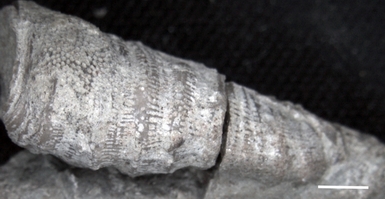
Click on thumbnail to enlarge the image.
Figure 12: Cornulites sp. 4, Ohesaare Formation, Pridoli from Ohesaare cliff, Saaremaa. Scale bar 2.0 mm. TUG 1658-5.
Cornulites sp. indet.
Material: One tube fragment.
Locality: Sauvere, Saaremaa, Estonia (Fig. 1 ![]() )
)
Stratigraphy: Paadla Formation, Sauvere Beds, Gorstian (upper Silurian) (Fig. 2 ![]() ).
).
Description: Minute slightly curved tubicolous shell. The exterior covered with well-developed somewhat irregular annulation. The annuli 2.0 mm thick at tube diameter 2.5 mm. Tube expanded moderately in diameter. Tube wall 0.4 mm thick.
Remarks: Studied specimen is weathered and too poorly preserved to study the details of external ornamentation and assign it to any definite species.
Genus Conchicolites , 1872
Conchicolites sp. 1
(Fig. 13 ![]() )
)
Material: One complete shell.
Locality: Hilliste quarry, Hiiumaa, Estonia (Fig. 1 ![]() ).
).
Stratigraphy: Hilliste Formation, Rhuddanian (lower Silurian) (Fig. 2 ![]() ).
).
Description: Small curved tubicolous shell completely attached to the substrate. Tube expanded very slowly in diameter. Tube divergence angle is about 7.5°. Tube externally covered with laterally well-developed peristome-like perpendicular ridges that are slightly tilted towards tube aperture. There are 7 ridges per 1 mm. At the contact with the substrate, perpendicular ridges protrude from the tube wall, otherwise tube base not widened. Tube lumen is smooth.
Remarks: Studied specimen is poorly preserved and lost its ornamentation by erosion at the mid-line of the tube.
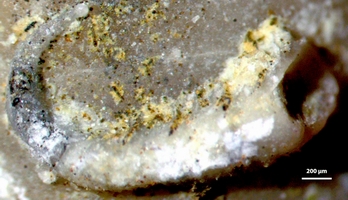
Click on thumbnail to enlarge the image.
Figure 13: Conchicolites sp. 1, Hilliste Formation, Rhuddanian from Hilliste Quarry, Hiiumaa.
Conchicolites sp. 2
(Fig. 14 ![]() )
)
Material: Three complete shells.
Locality: Marienthal and Kaugatuma cliff, Saaremaa, Estonia (Fig. 1 ![]() ).
).
Stratigraphy: Kuressaare Formation, Ludfordian to Kaugatuma Formation, Pridoli (upper Silurian) (Fig. 2 ![]() )
)
Description: Small slightly curved tubicolous shells, completely attached to the substrate. Tube is externally covered with closely spaced fine well-developed perpendicular ridges. The development of ridges is somewhat variable. Tube divergence angle is 7.0°. Adult tubes are up to 6.0 mm long and 1.5 mm wide. There are 7 to 8 ridges per 1 mm. Tube base not widened. Tube lumen is smooth.
Remarks: Conchicolites sp. 2 resembles somewhat C. sp. 1 in its small size and tube divergence angle, but it differs from C. sp. 1 in having coarser and more closely spaced perpendicular ridges. Studied specimens are attached to brachiopods and to a rugosan.
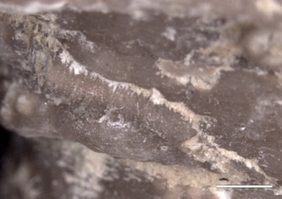
Click on thumbnail to enlarge the image.
Figure 14: Conchicolites sp. 2, Kuressaare Formation, Ludfordian from Marienthal, Saaremaa. Scale bar 1.5 mm. TUG 151-94.
Stratigraphic distribution
Cornulitids have a stratigraphic range from the Rhuddanian to the Pridoli in the Silurian of Estonia. There is remarkable gap in the distribution between the Rhuddanian and the Sheinwoodian, with no known cornulitids in the Aeronian or Telychian of Estonia. This is probably due to collecting bias and likely does not reflect the lack of cornulitids in most of the Lower Silurian sequence. Cornulitids are most abundant in the Sheinwoodian of Saaremaa followed by the Pridoli. The changes in abundance of cornulitids in the Silurian sequences of Estonia presumably reflect more facies preference than actual changes in the abundance of cornulitids in the ecosystem during the Silurian. Some cornulitid species are restricted to certain stratigraphic intervals. The Sheinwoodian is characterized by the occurrence of Cornulites cellulosus, C. aff. serpularius and C. stromatoporoides. Cornulites cellulosus is common in the Wenlock of Britain ( et al., 2007) and may have some correlation value, at least regionally. Cornulites sp. 4 is characteristic of the upper Pridoli of Estonia. The preliminary data presented here are far from complete. Future studies should describe the stratigraphic distribution of cornulitids in more detail in the Silurian of Estonia.
Diversity
The diversity of cornulitids in the Silurian of Estonia is relatively low (seven species), which is similar to that of Estonian Ordovician (, 2013). However, cornulitids have rarely been of interest to biostratigraphers and paleontologists in general. Thus it is likely that the low diversity is an artifact of collecting. No diversity trends can be recognized based on the studied material. There are three species in the Rhuddanian, three in the Sheinwoodian and three in the Pridoli. The single species in the Gorstian and Ludfordian represents a sampling bias rather than an actual change in diversity of cornulitids.
Facies distribution and ecology
Cornulitids occur in various beds that formed in normal marine conditions in the Silurian of Estonia. They are not known from the dolomites of the lagoons and shales of the deeper shelf. Shallow water stromatoporoid biostromes in the Ludfordian of Saaremaa also do not contain cornulitids. They have a facies range from pelletal limestones of shoals to marls of the deeper ramp. Unattached free forms are especially common in offshore deeper ramp marls, but they seldom occur also in limestones of open shelf. Gregarious aggregates are restricted to the limestones of the open shelf zone. Endobiotic cornulitid symbionts occur in the stromatoporoids of shoal and open shelf zone. Solitary attached forms occur in all the facies zones where cornulitids are present.
Financial support was provided to O.V. by the Paleontological Society through a Grant, Estonian Science Foundation grant ETF9064 and the Estonian Ministry of Education and Science through the target project SF0180051s08 (Ordovician and Silurian climate changes, as documented from the biotic changes and depositional environments in the Baltoscandian Palaeobasin). M.W. thanks Bill of Ohio State University and Jonah and Richa of the College of Wooster for assistance in the field. The authors are grateful to Tomasz for the constructive review. This paper is a contribution to IGCP 591 "The Early to Middle Palaeozoic Revolution".
D. (2006).- The fate of the homoctenids (Tentaculitoidea) during the Frasnian–Famennian mass extinction (Late Devonian).- Geobiology, Malden, vol. 4, p. 167–177.
B. (1964).- The Tentaculites of Bohemia: their morphology, taxonomy, ecology, phylogeny and biostratigraphy.- Czechoslovak Academy of Sciences, Praha, 215 p.
E. (1860).- Lethaea Rossica ou paléontologie de la Russie, décrite et figurée. 1, Seconde Section de l'ancienne Période.- Schweizerbart, Stuttgart, p. 1066-1188.- online: http://gallica.bnf.fr/ark:/12148/bpt6k97460g
D.W. (1962).- Small conoidal shells of uncertain affinities. In: C.D. (ed.), Treatise on Invertebrate Paleontology, Geological Society of America, New York; University of Kansas, Lawrence, Part W, p. 130–143.
L.G., A.T., M.P. (2007).- Systematics, shell structure and affinities of the Palaeozoic Problematicum Cornulites.- Zoological Journal of Linnean Society, London, vol. 150, p. 681–699.
O., L., P. & T. (eds., 2008).- The Seventh Baltic Stratigraphical Conference: Abstracts and Field Guide.- Geological Society of Estonia, Tallinn, 46 p.
M.J., R.A. & P.M. (2004).- The Silurian Period. In: F.M., J.G. & A.G. (eds.), A geologic time scale 2004.- Cambridge University Press, p. 188–201.
M.-A. (2006).- Intraspecific variation in Wenlock tabulate corals from Saaremaa (Estonia) and its taxonomic implications.- Proceedings of the Estonian Academy of Sciences, Geology, Tallinn, vol. 55, p. 24–42.
H. & R. (1977).- Model of facies and sedimentology for Paleobaltic epicontinental basin [in Russian]. In: D.L. (ed.), Facies and fauna Silurian of Baltica.- Institute of Geology AN ESSR, Tallinn, p. 89–121.
H.A. (1872).- On the genera Cornulites and Tentaculites and a new genus Conchicolites.- American Journal of Science, New Haven, vol. 3, p. 202–206.
A. & A. (1997).- Geology and mineral resources of Estonia.- Estonian Academy Publishers, Tallinn, 436 p.
E.F. (1820).- Die Petrefaktenkunde auf ihrem jetzigen Standpunkte durch die Beschreibung seiner Sammlung versteinerter und fossiler Überreste des Thier- und Pflanzenreiches der Vorwelt erläutert. Becker'sche Buchhandlung, Gotha, 436 p.
F. (1858).- Untersuchungen über die silurische Formation von Estland, Nord-Livland und Öesel.- Archiv für die Naturkunde Liv- Ehst- und Kurlands, Tartu, (Serie 1), 248 p.
P.D. & M.A. (2003).- Palaeoecology and evolution of marine hard substrate communities.- Earth Science Reviews, Amsterdam, vol. 62, p. 1–103.
P.D., O. & M.A. (2010).- Evolution of biomineralization in "lophophorates".- Special Papers in Palaeontology, London, vol. 84, p. 317-333.
O. (2009).- Attempted predation on Early Paleozoic cornulitids.- Palæogeography, Palæoclimatology, Palæoecology, Amsterdam, vol. 273, p. 87–91.
O. (2010).- Adaptive strategies in the evolution of encrusting tentaculitoid tubeworms.- Palæogeography, Palæoclimatology, Palæoecology, Amsterdam, vol. 292, p. 211–221.
O. (2013).- Cornulitid tubeworms from the Ordovician of eastern Baltic.- Carnets de Géologie [Notebooks on Geology], Brest, Letter 2013/03 (CG2013_L03), p. 131-138. DOI: 10.4267/2042/51214
O. & H. (2009).- Calcareous tubeworms of the Phanerozoic.- Estonian Journal of Earth Sciences, Tallinn, vol. 58, p. 286–296.
O. & M.A. (2010).- Endosymbiotic Cornulites in the Sheinwoodian (Early Silurian) stromatoporoids of Saaremaa, Estonia.- Neues Jahrbuch für Geologie und Paläontologie, Abhandlungen, Stuttgart, vol. 257, p. 13-22.
O. & M. (2012).- Phenetic phylogenetics of tentaculitoids - extinct problematic calcareous tube-forming organisms.- GFF, Stockholm, vol. 134, p. 145-156.
J.M. & A.I. (2011).- Dissecting the global diversity trajectory of an enigmatic group: The paleogeographic history of tentaculitoids.- Palæogeography, Palæoclimatology, Palæoecology, Amsterdam, vol. 312, p. 54–65.
M. & T. (2013).- Encrustation patterns on post-extinction early Famennian (Late Devonian) brachiopods from Russia.- Historical Biology, Abingdon, vol. 25, p. 1–12.
M., H. & T. (2013).- Microconchids of the species Microconchus valvatus ( in , 1831) from the Upper Muschelkalk (Middle Triassic) of Germany.- Palaeobiodiversity and Palaeoenvironments, Heidelberg, 9 p. DOI: 10.1007/s12549-013-0128-6
M., O. & M. (2012).- Invasion of freshwater and variable marginal marine habitats by microconchid tubeworms - an evolutionary perspective.- Geobios,Villeurbanne, vol. 45, p. 603-610.